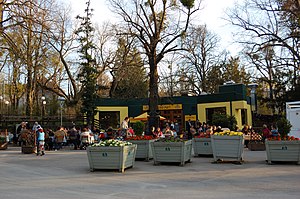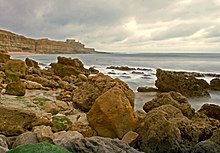| Revision as of 13:39, 27 January 2015 editHyosinn (talk | contribs)111 edits unnecessary← Previous edit | Revision as of 13:39, 27 January 2015 edit undoHyosinn (talk | contribs)111 editsmNo edit summaryNext edit → | ||
| Line 3: | Line 3: | ||
| ] in ] during the early afternoon]] | ] in ] during the early afternoon]] | ||
| ] in ] during the late afternoon]] | ] in ] during the late afternoon]] | ||
| '''Afternoon''' is the time of ] between ] and ]. It is the time when the ] is descending from its peak in the ] to somewhat before its terminus at the ] in the west. In ] life, it occupies roughly the latter half of the standard ] and school day. It is also associated with a number of concerns related to health, safety, and economic productivity: generally, the early afternoon, after most people have eaten lunch, corresponds to decreased work performance, decreased alertness, and a higher incidence of ]s. The equivalents of ]'s afternoon on other ]s last for very different periods of time and may have unpredictable effects on these planets' ]. | '''Afternoon''' is the time of the ] between ] and ]. It is the time when the ] is descending from its peak in the ] to somewhat before its terminus at the ] in the west. In ] life, it occupies roughly the latter half of the standard ] and school day. It is also associated with a number of concerns related to health, safety, and economic productivity: generally, the early afternoon, after most people have eaten lunch, corresponds to decreased work performance, decreased alertness, and a higher incidence of ]s. The equivalents of ]'s afternoon on other ]s last for very different periods of time and may have unpredictable effects on these planets' ]. | ||
| ==Terminology== | ==Terminology== | ||
Revision as of 13:39, 27 January 2015
For other uses, see Afternoon (disambiguation).


Afternoon is the time of the day between noon and evening. It is the time when the sun is descending from its peak in the sky to somewhat before its terminus at the horizon in the west. In human life, it occupies roughly the latter half of the standard work and school day. It is also associated with a number of concerns related to health, safety, and economic productivity: generally, the early afternoon, after most people have eaten lunch, corresponds to decreased work performance, decreased alertness, and a higher incidence of motor vehicle accidents. The equivalents of Earth's afternoon on other planets last for very different periods of time and may have unpredictable effects on these planets' life-forms.
Terminology
Afternoon is the time occurring between noon and evening. The specific range of time this encompasses varies in one direction: noon is currently defined as a constant 12:00 pm, but when afternoon ends is dependent on when evening begins, for which there is no standard definition. However, before a period of transition from the twelfth to fourteenth centuries, noon instead referred to 3 pm—possible explanations include shifting times for prayers and midday meals, along which one concept of noon was defined—and so afternoon would have referred to a narrower timeframe.
The word afternoon, which derives from after and noon, has been attested from about the year 1300; Middle English contained both afternoon and the synonym aftermete. The standard locative marking for the word was at afternoon in the fifteenth and sixteenth centuries but has shifted to in the afternoon since then. In Southern U.S. and Midland American English, the word evening is sometimes used to encompass all times between noon and night. The Irish language contains four different words to mark time intervals from late afternoon to nightfall, this period being considered mystical. Metaphorically, the word afternoon refers to a relatively late period in the expanse of time or in one's life.
Events

Afternoon is a time when the sun is descending from its daytime peak. During the afternoon, the sun moves from roughly the center of the sky to deep in the west. In late afternoon, sunlight is particularly bright and glaring, because the sun is at a low angle in the sky. The standard working time in most industrialized countries goes from the morning to the late afternoon or evening—archetypally, 9 am to 5 pm—so the latter part of this time takes place in the afternoon. Schools usually let out during the afternoon as well.
Effects on living organisms
Hormones and body temperature
In diurnal animals, it is typical for blood levels of the hormone cortisol—which is used to increase blood sugar and aid metabolism and is also produced in response to stress—to be most stable in the afternoon after decreasing throughout the morning. However, cortisol levels are also the most reactive to environmental changes unrelated to sleep and daylight during the afternoon. As a result, this time of day is considered optimal for researchers studying stress and hormone levels. Plants generally have their highest photosynthetic levels of the day at noon and in the early afternoon, owing to the sun's high angle in the sky. The large proliferation of maize crops across Earth has caused tiny, harmless fluctuations in the normal pattern of atmospheric carbon dioxide levels, since these crops photosynthesize large amounts of carbon dioxide during these times and this process sharply drops down during the late afternoon and evening.
In humans, body temperature is typically highest during the mid to late afternoon. However, human athletes being tested for physical vigor on exercise machines showed no statistically significant difference after lunch. Owners of factory farms are advised to use buildings with an east–west (as opposed to north–south) orientation to house their livestock, because an east–west orientation generally means thicker walls on the east and west to accommodate the sun's acute angle and intense glare during late afternoon. When these animals are too hot, they are more likely to become belligerent and unproductive.
Alertness

The afternoon, especially the early afternoon, is associated with a dip in a variety of areas of human cognitive and productive functioning. Notably, motor vehicle accidents are common in the early afternoon, when drivers presumably have recently finished lunch. A study of motor accidents in Sweden between 1987 and 1991 found that the time around 5 pm had by far the most accidents: around 1,600 at 5 pm compared to around 1,000 each at 4 pm and 6 pm. This trend may have been influenced by the afternoon rush hour, but the morning rush hour showed a much smaller increase. In Finland, accidents in the agriculture industry are most common in the afternoon, specifically Monday afternoons in September.
One psychology professor studying circadian rhythms found that his students performed somewhat worse on exams in the afternoon than in the morning, but even worse in the evening. Neither of these differences, however, was statistically significant. Four studies carried out in 1997 found that subjects who were given tests on differentiating traffic signs had longer reaction times when tested at 3:00 pm and 6:00 pm than at 9:00 am and 12:00 pm. These trends held across all four studies and for both complex and abstract questions.
Human productivity routinely decreases in the afternoon. Power plants have shown significant reductions in productivity in the afternoon compared to the morning, the largest differences occurring on Saturdays and the smallest on Mondays. One 1950s study covering two female factory workers for six months found that their productivity was 13 percent lower in the afternoon, the least productive time being their last hour at work. It was summarized that the differences came from personal breaks and unproductive activities at the workplace. Another, larger study found that afternoon declines in productivity were greater during longer work shifts.
It is important to note, however, that not all humans share identical circadian rhythms. One study across Italy and Spain had students fill out a questionnaire, then ranked them on a "morningness–eveningness" scale. The results were a fairly standard bell curve. Levels of alertness over the course of the day had a significant correlation with scores on the questionnaire. All categories of participants—evening types, morning types, and intermediate types—had high levels of alertness from roughly 2 pm to 8 pm, but outside this window their alertness levels corresponded to their scores.
See also
Notes
- ^ "Afternoon". Merriam-Webster. Retrieved October 9, 2014.
- "Noon". Merriam-Webster. Retrieved October 9, 2014.
- ^ "Evening". Merriam-Webster. Retrieved October 9, 2014.
- "noon (n.)". Online Etymology Dictionary. 2001. Retrieved October 10, 2014.
- "afternoon (n.)". Online Etymology Dictionary. 2001. Retrieved October 10, 2014.
- Ekirch 2006, p. xxxii
- ^ Aggarwal & Upadhyay 2013, p. 172
- "Nine-to-fiver". Merriam-Webster. Retrieved October 9, 2014.
- Blaskovich 2011, p. 74
- Sinclair & Weiss 2010, p. 118
- ^ Refinetti 2006, p. 556
- McCabe 2004, p. 588
- Refinetti 2006, p. 559
- McCabe 2004, p. 471
- McCabe 2004, p. 590
- Ray 1960, p. 11
- Ray 1960, p. 12
- Ray 1960, p. 18
- Refinetti 2006, p. 561
References
- Aggarwal, Anjali; Upadhyay, Ramesh (2013). Heat Stress and Animal Productivity. Springer Publishing. ISBN 978-8-132-20879-2.
{{cite book}}: Invalid|ref=harv(help) - Blaskovich, Jim (2011). Social Psychophysiology for Social and Personality Psychology. ISBN 978-0-85702-405-3.
{{cite book}}: Invalid|ref=harv(help) - Ekirch, A. Roger (2006). At Day's Close: Night in Times Past. W. W. Norton & Company. ISBN 978-0-393-32901-8.
{{cite book}}: Invalid|ref=harv(help) - McCabe, Paul T. (2004). Contemporary Ergonomics. CRC Press. ISBN 0-8493-2342-8.
{{cite book}}: Invalid|ref=harv(help) - Ray, James T. (1960). Human Performance as a Function of the Work–Rest Cycle. National Academy of Sciences.
{{cite book}}: Invalid|ref=harv(help) - Refinetti, Roberto (2006). Circadian Physiology (2nd ed.). Taylor & Francis Group. ISBN 978-0-8493-2233-4.
{{cite book}}: Invalid|ref=harv(help) - Sinclair, Thomas M.; Weiss, Albert (2010). Principles of Ecology in Plant Production. University of Nebraska, Lincoln/University of Florida.
{{cite book}}: Invalid|ref=harv(help)
External links
 Media related to Afternoon at Wikimedia Commons
Media related to Afternoon at Wikimedia Commons The dictionary definition of afternoon at Wiktionary
The dictionary definition of afternoon at Wiktionary
| Parts of a day | ||
|---|---|---|
| Daytime |  | |
| Twilight | ||
| Night | ||
| Related | ||